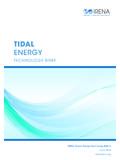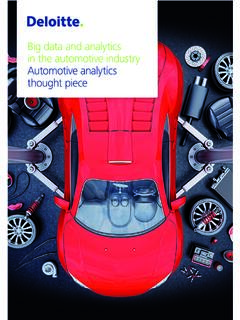Transcription of Utility-scale batteries – Innovation Landscape Brief
1 Utility-scale batteries Innovation Landscape Brief IRENA 2019 Unless otherwise stated, material in this publication may be freely used, shared, copied, reproduced, printed and/or stored, provided that appropriate acknowledgement is given of IRENA as the source and copyright holder. Material in this publication that is attributed to third parties may be subject to separate terms of use and restrictions, and appropriate permissions from these third parties may need to be secured before any use of such 978-92-9260-139-3 Citation: IRENA (2019), Innovation Landscape Brief : Utility-scale batteries , International Renewable Energy Agency, Abu report was prepared by the Innovation team at IRENA s Innovation and Technology Centre (IITC) with text authored by Arina Anisie and Francisco Boshell, with additional contributions and support from Santosh Kamath, Harsh Kanani and Shikhin Mehrotra (KPMG India).
2 Valuable external review was provided by Patrick Clerens and Jean-Michel Durand (EASE Storage Association), Derek Stenclik and Vlad Duboviks (General Electric), and Michael Taylor, Pablo Ralon, Martina Lyons, Nina Litman-Roventa and Paul Komor (IRENA).Report available online: questions or to provide feedback: publication and the material herein are provided as is . All reasonable precautions have been taken by IRENA to verify the reliability of the material in this publication. However, neither IRENA nor any of its officials, agents, data or other third-party content providers provides a warranty of any kind, either expressed or implied, and they accept no responsibility or liability for any consequence of use of the publication or material herein.
3 The information contained herein does not necessarily represent the views of all Members of IRENA. The mention of specific companies or certain projects or products does not imply that they are endorsed or recommended by IRENA in preference to others of a similar nature that are not mentioned. The designations employed and the presentation of material herein do not imply the expression of any opinion on the part of IRENA concerning the legal status of any region, country, territory, city or area or of its authorities, or concerning the delimitation of frontiers or are from Shutterstock unless otherwise document does not represent the official position of IRENA on any particular topic. Rather, it is intended as a contribution to technical discussions on the promotion of renewable storage increases flexibility in power systems, enabling optimal use of variable electricity sources like solar photovoltaic (PV) and wind ARE Utility-scale batteries ?
4 Stationary batteries can be connected to distribution/transmission networks or power-generation assets. Utility-scale storage capacity ranges from several megawatt-hours to hundreds. Lithium-ion batteries are the most prevalent and mature SNAPSHOT 10 GW of battery storage is deployed globally (2017) batteries with a total annual production of 27 MWh are providing of total enhanced frequency regulation capacity in UK. A demonstration project in US showed that a 4 MW/40 MWh battery can save USD 2 million in fuel costs and 400 hours of grid BENEFITSB atteries can provide services for system operation and for solar PV and wind generators, defer investments in peak generation and grid GENERATORS Reduced renewable curtailment Renewable capacity firmingSYSTEM OPERATION Frequency regulation Flexible ramping Black start servicesINVESTMENT DEFERRAL Transmission and distribution congestion relief Energy shifting and capacity investment deferralRenewable generatorsTransmission networksDistribution network2 KEY ENABLING FACTORSR educed upfront costsConducive regulatory framework Pilot projects and knowledge disseminationINNOVATION Landscape BRIEF4 ENABLING TECHNOLOGIESSYSTEM OPERATIONBUSINESS MODELSMARKET DESIGNINNOVATIONDIMENSIONS1 Utility scale batteries2 Behind-the-meter batteries3 Electric-vehicle smart charging4 Renewable power-to-heat5 Renewable
5 Power-to-hydrogen6 Internet of Things7 Artificial intelligence and big data8 Blockchain9 Renewable mini-grids 10 Supergrids11 Flexibility in conventional power plants12 Aggregators13 Peer-to-peer electricity trading 14 Energy-as-a-service15 Community-ownership models16 Pay-as-you-go models17 Increasing time granularity in electricity markets18 Increasing space granularity in electricity markets 19 Innovative ancillary services20 Re-designing capacity markets21 Regional markets22 23 Market integration of distributed energy resources24 Net billing schemes25 Future role of distribution system operators26 Co-operation between transmission and distribution system operators27 Advanced forecasting of variable renewable power generation28 Innovative operation of pumped hydropower storage29 Virtual power lines30 Dynamic line ratingABOUT THIS BRIEFThis Brief is part of the IRENA project Innovation Landscape for a renewable-powered future , which maps the relevant innovations, identifies the synergies and formulates solutions for integrating high shares of variable renewable energy (VRE) into power synthesis report, Innovation Landscape for a renewable-powered future: Solutions to integrate variable renewables (IRENA, 2019), illustrates the need for synergies among different innovations to create actual solutions.
6 Solutions to drive the uptake of solar and wind power span four broad dimensions of Innovation : enabling technologies, business models, market design and system with the synthesis report, the project includes a series of briefs, each covering one of 30 key innovations identified across those four dimensions. The 30 innovations are listed in the figure batteries This Brief provides an overview of Utility-scale stationary battery storage systems -also referred to as front-of-the-meter, large-scale or grid-scale battery storage- and their role in integrating a greater share of VRE in the system by providing the flexibility needed. The Brief highlights some examples of large-scale battery storage deployment and the impact of this technology on the power system.
7 The Brief is structured as follows:IDescription IIContribution to power sector transformationIIIKey factors to enable deployment IVCurrent status and examples of ongoing initiativesVImplementation requirements: Checklist Innovation Landscape BRIEF6I. DESCRIPTIONThe growing share of VRE sources, such as solar and wind, calls for a more flexible energy system to ensure that the VRE sources are integrated in an efficient and reliable manner. Battery storage systems are emerging as one of the potential solutions to increase system flexibility, due to their unique capability to quickly absorb, hold and then reinject electricity. According to the Energy Storage Association of North America, market applications are commonly differentiated as: in-front of the meter (FTM) or behind-the-meter (BTM).
8 FTM batteries are connected to distribution or transmission networks or in connection with a generation asset. They provide applications required by system operators, such as ancillary services or network load relief. BTM batteries are interconnected behind the utility meter of commercial, industrial or residential customers, primarily aiming at electricity bill savings through demand-side management (ESA, 2018). This Brief focuses on how Utility-scale stationary battery storage systems also referred to as front-of-the-meter, large-scale or grid-scale battery storage can help effectively integrate VRE sources into the power system and increase their share in the energy mix.
9 Unlike conventional storage systems, such as pumped hydro storage, batteries have the advantage of geographical and sizing flexibility and can therefore be deployed closer to the location where the additional flexibility is needed and can be easily scaled. Deployment of pumped hydro storage, on the other hand, requires specific geological conditions ( mountains and water). Utility-scale battery storage systems have a typical storage capacity ranging from around a few megawatt-hours (MWh) to hundreds of MWh. Different battery storage technologies, such as lithium-ion (Li-ion), sodium sulphur and lead acid batteries , can be used for grid applications.
10 However, in recent years, most of the market growth has been seen in Li-ion batteries . Figure 1 illustrates the increasing share of Li-ion technology in large-scale battery storage deployment, as opposed to other battery technologies, and the annual capacity additions for stationary battery storage. In 2017, Li-ion accounted for nearly 90% of large-scale battery storage additions (IEA, 2018).7 Utility-scale batteries Levelized Cost ($/MWh)The increasing share of Li-ion batteries in storage capacity additions has been largely driven by declining costs in Li-ion technology, which has in turn been driven by the ramp-up in production to meet growing demand for electric vehicles. Figure 2 depicts the current levelised cost of three storage technologies (Li-ion, flow battery vanadium, flow battery zinc bromide) for three battery sizes, aimed at different applications:Figure 1: Increasing share of Li-ion in annual battery storage capacity additions globally Figure 2.


















